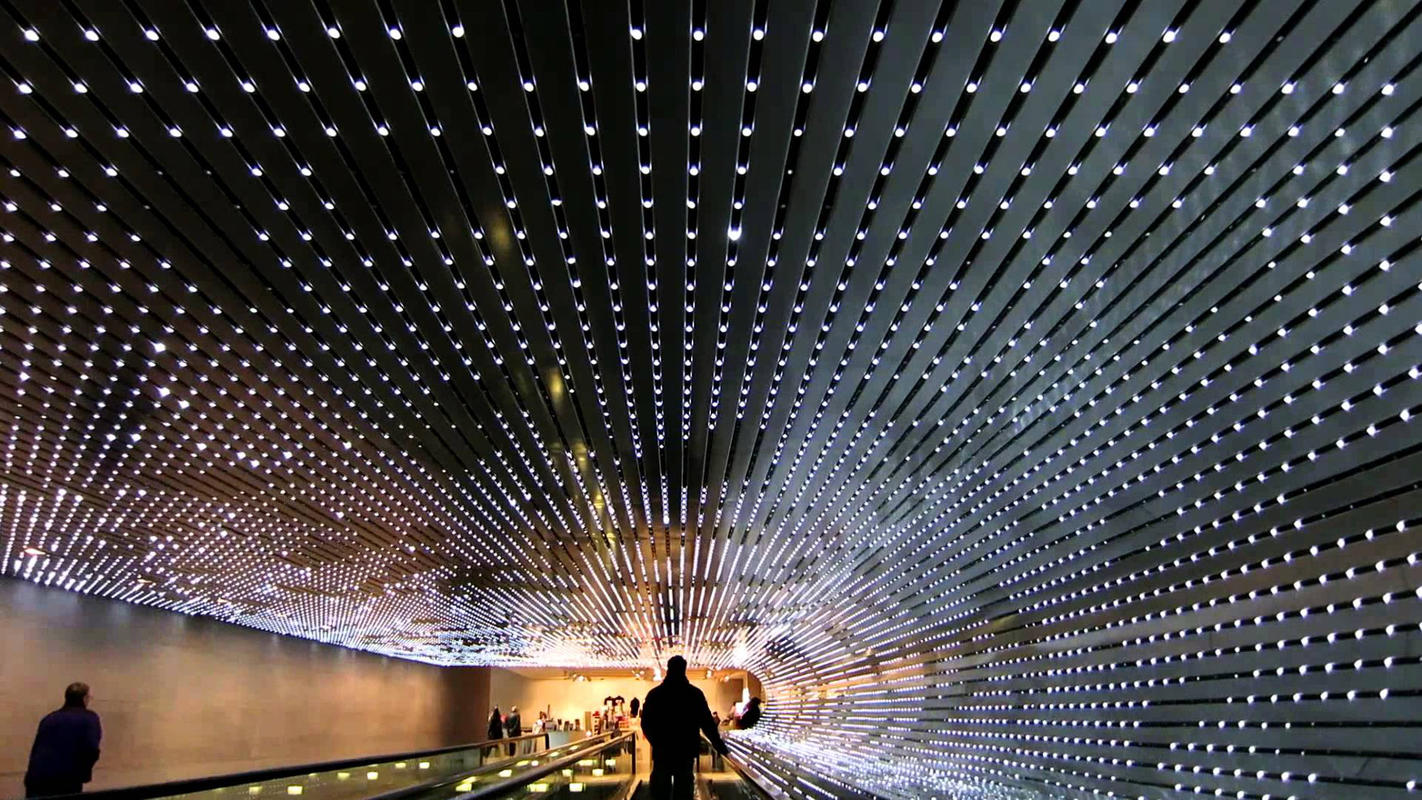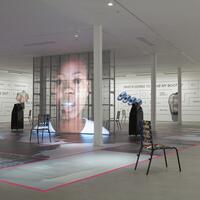More about Multiverse

Sr. Contributor
This 2008 light installation pays homage to 1990s visual hallucinations in the rave scene, while pointing ahead to the infinite potential of the multiverse.
You don’t visit the National Gallery of Art because you’re seeking a drug-like trip. But, you never know just how art might move you. As you pass through the 200-foot long Concourse walkway between the East and West buildings of the gallery, you just might feel like you’ve entered your own personal hallucination. Villareal’s 41,000 LED lights pulsate in a semi-random, computer-generated format all around. Play the right music on your headphones and you’ll immediately feel like you’re at a rave. Oh, and we can’t forget to mention that the moving bouncy walkway that takes you through this tunnel just enhances the effect.
This isn’t just about recreating a drug-induced vision, though. It’s about the deeper reason behind the use of the popular drugs that induce those visions. People use those drugs to get in touch with their deepest self. They often ingest pills and capsules and medicines of all kinds not because they want to escape the world, but because they want a small moment to capture that elusive feeling of being one with the universe. As we grow more and more scientifically aware, we now know that perhaps we don’t live in one single universe, but rather in a constellation of universes of which our universe is but one. We may live in a multiverse. Who wouldn’t want to get in touch with the amazing feeling that you are just a tiny speck in a multiverse and yet you are still an important part of that bigger picture? Isn’t that precisely the feeling great art should provide?
With this work, Villareal has created a framed version of space within the halls and walls of the National Gallery of Art. Of course, he’s hardly the first artist to do so. The gallery itself points out that looking at his piece might make you think of work by Dan Flavin, Jenny Holzer, James Turrell, and Felix Gonzalez-Torres. Each of these artists has contributed their own vision of light, space, and computer-generated art to the world. And yet, Multiverse conceptually doesn’t fit neatly in with those artists.
In fact, the gallery suggests that you might find him more conceptually linked with Peter Halley’s systems-based paintings or Sol LeWitt’s instructional wall drawings. In fact, Ellen Jaret wrote that “Sol LeWitt’s wall drawings are infamous renditions of the organized chaos of life,” which is a wonderful description we could also apply to this piece by Villareal. After all, the theory of a multiverse itself speaks to the organization within the chaos of the world. Similarly, in an interview with Vulture, artist Peter Halley said that his work “wasn’t just a cityscape, it was a diagram of contemporary life as it’s organized.”
These works are really all about how the human brain seeks patterns everywhere, even though life itself is not necessarily organized. We create systems or theories about natural systems that help us feel like we’re a little bit more in control because they give us a frame to understand life. And yet, the fact is, the universe (or the multiverse that contains it) is so much bigger, more complex, and perhaps more chaotic than we could ever possibly understand. Multiverse uses a computer-generated pattern of randomness, presenting that exact irony of using our technology to create a pattern that is complicated enough that the human eye viewing this work is unlikely to actually see the pattern.
There is a bit of artistic genius to the computer coding. The Washington Post explained, “Villareal uses two sets of algorithms, one of which samples the other, to provide a viewing experience that’s not quite infinite but might as well be.” The artist himself has said that he draws upon John Conway’s mathematical theories, essentially illustrating them using light. However, he also drew inspiration from nature itself, including examples of wave patterns, gravity, and friction. He’s an artist, not a scientist, but he draws heavily on nature-based science to express himself.
It’s also worth noting that it’s kind of a big deal that Villareal got this piece placed in the National Gallery of Art. The Washington Business Journal talked to someone from Conner Contemporary Art, which is the gallery Villareal is affiliated with in DC, who said that it’s truly amazing that someone doing cutting-edge computer-and-light installation work is showing alongside Gustave Courbet and Jasper Johns.
Finally, you might think that you hadn’t heard of this artist before. However, if you live in the San Francisco Bay Area, then you’ve seen his work. He’s the artist behind the light installation on The Bay Bridge. Thanks to that installation, he won a proposal to light up London’s bridges. So if you see a really cool light installation on a bridge in a major city, pause for a moment, and think of how tiny-but-important a piece of the multiverse you are.
Sources
- Bioephemera. A Twinkling Multiverse. Science Blogs. 3/31/08. Retrieved 3/26/19 from https://scienceblogs.com/bioephemera/2008/12/31/a-twinkling-multiverse
- Brown, Mark. New York Artist Gets Green Light to Illuminate London’s Bridges. The Guardian. 12/7/16. Retrieved 3/26/19 from https://www.theguardian.com/artanddesign/2016/dec/07/new-york-artist-gr…
- Jaret, Ellen. Wall Drawing 132. Sartle. Retrieved 3/26/19 from https://www.sartle.com/artwork/wall-drawing-132-sol-lewitt
- Jenkins, Mark. Leo Villareal exhibit is a light take on 1960s works. Washington Post. 6/7/12. Retrieved 3/26/19 from https://www.washingtonpost.com/entertainment/museums/leo-villareal-exhi…
- Lakin, Max. Vulture. Peter Halley on Dystopian Geometry, Why He Started Index Magazine, and How the ’80s Were No Party. 12/7/18 Retrieved 3/26/19 from https://www.vulture.com/2018/12/peter-halleys-paintings-are-a-diagram-o…
- National Gallery of Art. Leo Villareal - Multiverse. Retrieved 3/26/18 from https://www.nga.gov/collection/art-object-page.142055.html
- Plumb, Tierney. National Gallery Buys Work from DC Gallery Artist. Washington Business Journal. 10/9/9 Retrieved 3/26/19 from https://www.bizjournals.com/washington/stories/2009/10/05/daily100.htm

Contributor
This Leo Villareal work is like being inside that starfield screensaver from the '90s?
Throw on some headphones and bliss out in this trippy, beautiful light installation at the National Gallery of Art. Thousands of visitors are dazzled by these 41,000 LEDs daily as they wander down the 200-foot-long walkway.
Even cooler? The word “Multiverse” represents the hypothetical set of infinite possible universes, or “parallel universes,” that can exist. Leo programmed these lights to flash based on planned patterns mixed with an element of chance. Thus, you’ll never see a pattern repeated. The possibilities are truly infinite!












